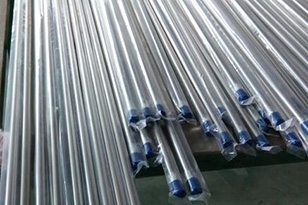Wall thickness defects of seamless stainless steel pipe
Wall thickness defects of seamless stainless steel pipe
Standard for wall thickness of seamless stainless steel pipe.
1. Generally, grade F is used for cold drawn tube, RA = 3.2 μ m, Grade E is used for cold rolled tube, RA = 1.6 μ m, the allowable deviation RA is 25%.
2. Seamless stainless steel pipe: with hollow cross-section, seamless stainless steel pipe is widely used for conveying fluid, such as oil, gas, water some solid materials. On the contrary, when the bending strength torsion strength are the same, the weight is lighter. It is a kind of economical section steel. It is widely used in the manufacture of structural mechanical parts, such as oil drill pipe, automobile transmission shaft, bicycle frame construction steel. Scaffold other steel pipes are used to manufacture rings, which can improve the utilization rate of materials, simplify the manufacturing process, save materials processing time, have been widely used in steel pipe manufacturing.
The process flow of two kinds of stainless steel pipe is summarized
1. Stainless steel tube cold drawing (rolling) seamless steel pipe: round tube blank → heating → piercing → heading → annealing → pickling → oiling (copper plating) → multi pass cold drawing (cold rolling) → billet tube → heat treatment → straightening → hydrostatic test (flaw detection) → marking → warehousing.
2. Hot rolling (seamless steel pipe): round billet → heating → piercing → three roll cross rolling, continuous rolling extrusion → pipe stripping → sizing ( reducing) → cooling → billet tube → straightening → hydrostatic test ( flaw detection) → marking → warehousing.
The surface defects of seamless stainless steel pipe are discussed analyzed.
At present, Ni based low temperature steel is used. Because of its excellent low-temperature toughness, it is widely used in low-temperature equipment vessels - 40 to - 196 ° C, the service temperature of low-temperature steel with nickel content of 9wt% is lower. 9Ni steel below - 196 ℃ is ferritic steel, the impact energy at low temperature (- 196 ℃) can reach 200-300j. It is a tough material used in the cryogenic environment of stainless steel seamless steel pipe plant, has good cold workability, weldability crack propagation resistance, so it has become an ideal material for LNG storage tank.
At present, the production technology of 9Ni sheet steel has been relatively mature, domestic enterprises can also produce it. However, the production technology of 9Ni seamless stainless steel pipe in China is mature needs further development. The related research materials of 9Ni mainly focus on composition adjustment sheet rolling process. Heat treatment process, microstructure evolution welding process, but there is no mention of product surface quality control.
The main purpose of precision stainless steel tube extrusion process.
The main goal of precision stainless steel tube extrusion is to stably produce high-precision products with small size deviation. One of the main dimensional accuracy problems is eccentricity.
In the manufacturing process of precision stainless steel pipe, there will always be some degree of eccentricity. By strictly controlling the process parameters material flow in the extrusion process of 304 stainless steel pipe, the processing error of extruded pipe size can be reduced to a small value.
The eccentricity of stainless steel tube is mainly attributed to the poor material temperature gradient, blank preparation, equipment alignment accuracy improper lubrication. The eccentricity may be caused by some reasons the result of the combined action of the above reasons. The purpose of the design is to minimize these effects compensate for their adverse effects during extrusion.
Before extrusion, temperature detection device should be used to check the temperature distribution of the blank on the blank feeding equipment. The material temperature trend is always displayed on the operation screen. The purpose of the calculation screen display of the billet temperature variation trend is to enable the operator to modify the induction furnace roof settings accordingly to compensate for the temperature gradient of the billet detected before the start of extrusion.















